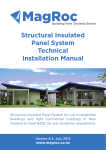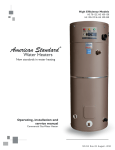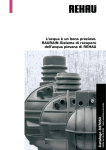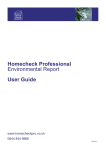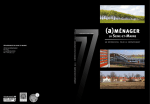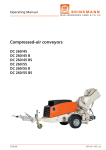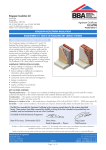Download Exhibition House: A user`s guide
Transcript
Exhibition House: a users’ guide how to achieve energy efficiency and low running costs 1 1.00 Contents 1.00 Contents 2.00 Key data / 1 3.00 3.01 3.02 Introduction / 2 Purpose of users’ guide / 2 Project vision / 2 4.00 Overview of the house and sustainability features / 3 Materials / 4 Services / 4 Rennovation and demolition / 5 4.01 4.02 4.03 10.00 10.01 10.02 10.03 10.04 10.05 Local amenity information / 22 Refuse / 22 Public transport / 22 Cycle routes / 22 Car parking / 22 Location of essential services / 22 11.00 Emergency information and procedures / 23 Location of emergency information / 23 Location of utility isolation / 23 Contact information / 23 11.01 11.02 11.03 5.00 5.01 5.02 5.03 5.04 5.05 5.06 5.07 5.08 5.09 5.10 5.11 5.12 5.13 5.14 5.15 Building fabric overview / 6 Masonry plinth wall / 6 Timber structure / 6 Timber cladding / 6 Chestnut shakes / 6 Trombé wall / 7 Air tightness membrane / 7 Floor screeds / 7 Cork and carpet floor finishes / 7 Sweet chestnut shingle roof / 8 Solar panel roof / 8 External wall / 8 Trombé wall / 9 Wall/window junction / 9 Ground floor construction / 10 Upper floor / external wall junction / 10 6.00 6.01 6.02 6.03 6.04 Joinery overview / 11 Single leaf external doors / 11 Sliding folding doors / 11 Windows / 11 Sliding sun shade / 11 Address: Exhibition House Exhibition Mews Bordon Hampshire GU35 0GY 7.00 7.01 7.02 7.03 7.04 7.05 Building services overview / 12 Keeping the house warm / 12 Keeping the house cool / 13 How to keep water bills down / 14 How to keep electric bills down / 14 The building services in detail / 14 Responsibility of: Lee Burn, East Hampshire District Council Position: Facilities manager 8.00 Users’ guide issue number: 1st edition Date: January 2013 8.03 8.04 Refit, rearrangement and demolition considerations / 19 Altering the fabric of the building / 19 Altering the structure of the building / 19 Lifetime Homes adaptations / 19 Design for demolition / 20 The garden / 21 Overview / 21 Terrace and lawn / 21 Garden shed / 21 Clothes dryer / 21 Water butts / 21 Composting bins / 21 Cold frame / 21 Raised beds / 21 Surface water drainage / 21 This users’ guide should be kept at all times in: Exhibition house, study 9.00 9.01 9.02 9.03 9.04 9.05 9.06 9.07 9.08 9.09 Electronic version available from: www.whitehillbordon.com Prepared by: Ian McKay of BBM Sustainable Design Limited Guide design consultant: Peter Brawne | Matter 8.01 8.02 2.00 Key data 2 3.00 Introduction 3.01 Purpose of user guide 3.02 Project vision This Users’ Guide sits alongside the Operations and Maintenance Manual (O&M Manual) prepared by Westridge Construction who built the house. The users’ guide provides an overview of the ideas behind the design of the house, its energy and resource efficient strategies, as well as descriptions of how elements are made and how they work. In order to demonstrate to existing and future residents of Whitehill and Bordon that green living can be enjoyable, the Eco-town team commissioned Riches Hawley Mikhail to design a two bedroom, four person exhibition house to demonstrate the opportunities of living a zero-carbon and sustainable lifestyle as well as a showcase for some of the technologies that such a lifestyle would include. BBM Sustainable Design were appointed to prepare the specification and construction information whilst retaining the initial concept of the house. In the interests of making it user friendly, the guide has been conceived to communicate predominantly through illustrations and photographs with supporting written descriptions and annotations. The householder should also be aware that if carrying out maintenance and material alterations to the building fabric and/or electrical and mechanical services of the property there is a digital appendix to the User Guide with a schedule of user guide updates. Use this document to record the nature, date and responsibility for the work. The master electronic version of this Microsoft Office document is held at East Hampshire District Council, Penns Place, Petersfield, Hampshire, GU31 4EX Our brief required the house to be designed as an exhibit, open to the public for a year, and then in the future it would become a family home. The project has provided a rare opportunity to test new design solutions and technologies for carbon neutral living without losing sight of the role that design plays in creating a liveable home: we wanted visible demonstrations of energy use and technologies, but not at the expense of a comfortable and pleasant living environment. Learning from the design and construction process for the exhibition house doesn’t end when the building work is over. This is why we have commissioned a User’s Manual. The different technologies – photovoltaic panels, solar thermal panels, inter-seasonal heat store, rainwater harvesting, mechanical ventilation and heat recovery unit, require some understanding in order to achieve the best performance from the home. We want future occupants and visitors to understand how the house works and that management and maintenance is as important as design and construction. The exhibition house is one of six exhibition buildings on the former Ministry of Defence fire station site. The main exhibition building is the refurbishment of the existing Edwardian former fire station, designed by BBM Sustainable Design. The building is now the ‘Ecostation’ with exhibition space, a lecture theatre and office space. There will also be exhibitions of history and local ecology and an adjacent old stable block has been retained. The refurbishment has focused on improving the thermal performance of the building – adding insulation to some of the floors, walls and roof as well as installing new energy efficient gas boilers. In 2013, the construction of three terraced houses will commence. These will demonstrate how eco-homes can be affordable, and provide a model for future homes in the town. Radian Housing Group is the client for this project working with Ash Sakula Architects. The final project will be the refurbishment of the existing drill tower. It will be clad in solar panels and contribute to the energy efficiency of the Eco-station. Together these projects should provide a learning resource for the Eco-town and beyond. 3 4.00 Overview of the house and sustainability features � � �� ��� �� �� � � � ��� � �� ��� ��� �� �� �� �� �� Ground floor �� north � � � � ��� ��� Exhibition house floor plans at a scale of 1:200 ��� Key: � � ��� � �� ��� ��� ��� � First floor � � � � � � ��� ��� ��� � � ��� Loft � The rooms in the house are organised to respond to both the environmental and exhibition requirements of the brief. A central circulation route allows easy movement of the public as for an exhibition. In terms of reducing the demand for energy to heat the house, the sedentary spaces: the living room, dining area, main bedroom and study, are located in the warmest part of the house. These south facing rooms benefit from two passive design features built into the south facing wall – a winter garden and a trombé wall. The kitchen, bathrooms and the entrance hall are in the coldest part of the house, forming a buffer to the walls that face north and therefore don’t benefit from the warmth of the sun. 1. Driveway 2. Entrance lobby 3. Hall 4. Accessible W.C. 5. Living room 6. Trombé wall 7. Winter garden 8. Kitchen / diner 9. Shed storage 10. Bin store 11. Water collection 12. Garden 13. Inter-seasonal heat store (underground) 14. Main bathroom 15. Bedroom 1 16. Void 17. Mezzanine level 18. Bedroom 2 19. Services cupboard 20. Outline of possible future Lifetime Homes lift access 21. Attic 22. Photovoltaic and solar thermal panels on standing seam metal roof 23. Sweet chestnut shingle roof � The winter garden traps heat between two layers of glass in winter, while in summer the outer layer of glazing can be left permanently open, providing a covered area at ground floor for a table and chairs, and a balcony off the master bedroom at first floor level. The trombé wall works from the sun heating an area of clay blocks that provide thermal mass, which stores and radiates heat internally, a timber screen gives shade so the wall does not overheat in the summer. The open circulation not only creates views to different floors but it also acts as a route for passive ventilation to all the rooms. At the centre of the stair- case is a service duct connecting to the mechanical ventilation unit. The ground floor is fully wheelchair accessible, conforming to the requirements of Lifetime Homes. This standard comprises 16 design criteria that can be universally applied to new homes to make them more convenient and accessible to the broadest range of homeowners including elderly people and those with physical disabilities. It includes future adaptation features which are explained in section 8.0. The design has considered future changes to the house and allows for demolition and salvage. 4 4.00 Overview of the house and sustainability features ��� ��� ��� ��� ��� ��� ��� ��� ��� Understanding ������������the ���basic �����principles � behind the low energy design of the ������������ house will help the homeowner interact ������������������ and control the various technologies as �������� well as exploit the most energy efficient ������������������� modes of operation. ��������������� ��������������� ����������������� ������������������� ���������������� ������������� Buildings impact the environment when �������������������� they are built, when they are in use and ���������� ����������������������������� finally when they are demolished. With �������������� good design we can minimize these ����������������� impacts at every stage of the energy ������������� lifecycle �������� of the house. Starting with the energy and environmental impact of ������������������� how the house was built, the design������������� ��������������������� ers have opted mainly for materials ������������������������������ that have been grown, such as timber ��������������������������� products. There is generally far less ��������� energy involved in making buildings out �������������������������� of wood than say, brick and concrete. ��������������������������� The���������������� material itself is renewable (it can ������������������������������� be re-grown) and wood products lock 4.01 Materials �� �� �� Section A-A ��������� �� Sectiion A-A �� �� �� Section C-C ������ ����� Sectiion C-C ��� ��� ��� ��� ��� ��� ��� �� ��� �� �� Section Sectiion B-B �������B-B �� �� �� Section D-D Sectiion D-D ������ ����� �� carbon out of the atmosphere through photosynthesis, as a result of which wood has no carbon emissions. 25 years growth cycle 100 + years growth cycle 4.02 Services The house has been designed to nurture low carbon lifestyles for its inhabitants. It incorporates simple technologies such as the external clothes line, a bike store to support low carbon transport, recycling storage in the kitchen and garden shed and a garden design which supports the growing of food and recycling of food waste. The home working study points to a more flexible and efficient way of working where daily commuting can be avoided. near left above: Exhibtion house is predominantly built out of prefabricated timber. Building in timber is good for the environment as there is minimal processing energy required and in itself it is a form of ‘carbon locking’. near left bottom: Exhibtion house is externally clad in glue-laminated lengths of coppiced sweet chestnut which is grown and manufactured in the Sussex Weald. far left: The coppiced technique of harvesting timber benefits from a mature root stock to regenerate the timber at a far greater rate than that of conventional logging (far left). As such it is regarded as the fastest way of growing hardwood and ‘locking carbon’! 5 4.00 Overview of the house and sustainability features There is also an electric car charging point fitted within the bike shed. While it utilizes daytime energy produced by the solar photovoltaic panels on the roof of the house, it will provide truly low carbon transport. It also has a range of energy systems which can help the homeowner cut down on utility bills. (See section 7.0) The most important aspect of designing a low energy house is first to ensure you have reduced the demand for heat and power. In the Exhibition house this means really thick walls, roofs and floors filled with thermal insulation. So much insulation in fact, that the house effectively will not need any form of artificial space heating input for all but the very dullest and coldest days of the year. You can read more detail on the materials and construction of the exhibition house in sections 5.0 and 6.0. The house also makes its own energy both passively and actively. It uses the sun’s energy to produce heat and electrical energy and it collects rainwater for use in the flushing of the downstairs WC and washing machine. It has water efficient sanitary fittings, LED lighting technology and a power ‘OFF’ button by the front door, which you can press when you want to turn off all the left on lights and non-essential power sockets in the house. You can read more on building services in section 7.0. 4.03 Renovation and Demolition Buildings are a valuable resource for society as a whole and they must be capable of adaptation for new uses. If and when their useful life comes to an end, then the constituent parts of the construction and all the fittings need to be salvaged in such a way so as to maximize potential for re-use in other buildings or some form of recycling. The exhibition house has been designed to be environmentally safe and easy to salvage. top: The inter-seasonal heat store is buried deep in the ground - the base is about 4.5m below the garden. It is seen here during construction. bottom: These diagrams show the principles behind making a building like Exhibtion house super-insulated whereby most of the space heating requirements are met by well controlled solar gain and the day to day living activities of the occupants. 6 5.00 Building fabric overview This section describes the construction of the house with an overview of the principles behind different materials and construction elements, what purposes they serve and detailed drawings showing the fabric of the building. Look out for the ‘watch points’ giving information about upkeep and maintenance. 5.01 Masonry plinth wall The plinth wall lifts the timber structure off the ground keeping it clear of ground water and rain splashes. The photo opposite shows the wall from above at the junction of the draught lobby and living room wall with the east facing external wall. The facing brick, full cavity fill polystyrene insulation and concrete block inner leaf can clearly be seen. The bricks are sourced from the Feshfield Lane Brickworks in East Sussex. 5.02 Timber structure Above the plinth wall, the house is constructed of prefabricated timber frame cassettes. The photo shows the western gable at the south corner. The engineered timber studs and rafters can be seen between the Oriented Strand Board (OSB) sheathing. Soft wood plates separate the upper and lower sections of the cassettes. 5.03 Timber cladding The cladding of the house is made from coppiced sweet chestnut which has been cut and glue-laminated together to form long continuous planks that reduce warping. The timber has been treated with a penetrating oil which retards the leaching of natural tanins. The tanin is a natural preservative but it can lead to tea coloured staining if cuts or penetrations are made to the cladding and are left untreated. The sweet chestnut comes from the Sussex Weald. 5.04 Chestnut shakes The roof cladding on the north pitch is untreated chestnut shakes. In normal conditions the material is likely to provide a weatherproof finish for upwards of fifty years. 7 5.00 Building fabric overview 5.05 Trombé wall The trombé wall provides the house with a thermal store; daytime solar energy is radiated into the interior providing evening warmth to rooms. The natural clayblocks and clay plaster come from the Freshfield Lane Brickworks in East Sussex. The outer glazed panel consists of a multi-skin polycarbonate panel filled with aerogel which is a new generation of super-insulation materials which allows the sun’s radiant energy to penetrate through to the clay blocks but inhibits escaping convected heat. 5.06 Air tightness membrane The inside face of the timber structure is clad in an air tightness and vapour control membrane. In a super-insulated house with a mechnical ventilation system with heat recovery (MVHR) it is essential to reduce air leakage to an absolute minimum. The membrane performs this role along with a range of tapes and grommets (or eyelets) as seen in the photo. 5.07 Floor screeds The sand and cement screeds on the floors provide thermal mass preserving stable internal comfort conditions. As a result, occupants should remain cool even when air temperatures are rising above normal comfort conditions. Thermal mass is important for helping to iron out fluctuations in air temperature. It becomes particularly important in very hot weather where outside air brought into the house exceeds normal comfort conditions. If the fabric of the house can absorb excess heat, it acts as a buffer in those extreme weather scenarios. 5.08 Cork and carpet floor finishes The cork floor finish has excellent eco-credentials: cork can be harvested from the same tree for about 200 years and no trees are cut down to extract the material. The floors have been finished with two extra coats of acrylic varnish. From time to time it will become necessary to reapply a coat of varnish. The carpet is from UK producer Axminster from their Swaledale range. It is made using wool from Swaledale sheep which is a hardy breed with an inherent amount of natural grey fibre in the pile which can be distinguished in the lighter colours of this minimally processed carpet. Swaledale is thought to be the first accredited carbon neutral carpet. 8 5.00 Building fabric overview 5.09 Sweet chestnut shingle roof 1 2 3 4 5 7 6 8 9 Description This is the section of roof over the north facing pitch of the house. The roof consists of engineered timber i-beams (‘tgi joists’) which are sandwiched between oriented strand board (OSB) to form pre-fabricated cassettes. The upper face has a breather membrane which beads water but allows water vapour to escape the construction. Chestnut shakes form the outer roof finish. The joists are infilled with ‘Warmcell’ celulose insulation. The section has a plasterboard finish to the underside fixed to softwood battens which forms a service zone but where it encloses the attic space, there is no plasterboard finish and the foil backing of the soffit insulation is exposed. Watch points The taped foil backing of the roof insulation forms the vapour barrier and air tightness membrane of the building. If you inadvertently puncture the foil backing, reseal immediately with suitable foil tape. 10 11 Construction build-up 1. Sweet chestnut shakes 2. Reinforced bitumen membrane interlay 3. Treated ex38x25mm sw battens and counter battens as (provides min 50mm clear ventilation) 4. Vapour permeable roof underlay (Pro clima ‘Solitex Plus’) 5. 18mm oriented strand board outer sheathing layer (OSB3) 6. 400mm deep timber i-beam rafter 7. Blown-in gypsum impregnated recycled newsprint insulation 8. 9mm oriented strand board outer sheathing layer (OSB3) 9. Polyurethane soffit insulation (Kingspan Kooltherm K7) with integral vapour control membrane with taped joints 10. Vapour control membrane as (9.) 11. 12.5mm plasterboard and plaster skim on 25mm deep softwood battens U-Value 0.079W/m2Kº 5.10 Solar panel roof Description This is the section of roof over the south facing pitch of the house. The roof structure is the same as the north facing pitch but differs in having a roof finish of solar thermal and solar photovotaic panels. These are fixed to a standing seam metal roof mounted on gapped softwood boards, ventilating to the underside of the metal sheet. The metal sheet is aluminium coated in galvanized zinc. 1 2 3 5 6 4 7 8 9 10 11 12 Watch points The taped foil backing of the roof insulation forms the vapour barrier and air tightness membrane of the building. If you inadvertently puncture the foil backing, reseal immediately with suitable foil tape. U-Value 0.079W/m2Kº 13 Construction build-up: 1. Solar thermal or solar photovoltaic panels 2. Fixing rail 3. Aluzinc standing seam (metal) roof 4. Gapped softwood boarding 5. Softwood battens forming ventilated cavity 6. Vapour permeable roof underlay (Pro clima ‘Solitex Plus’) 7. 18mm oriented strand board outer sheathing layer (OSB3) 8. Engineered timber i-beam rafter 9. Blown-in gypsum impregnated recycled newsprint insulation 10. 9mm oriented strand board inner sheathing layer (OSB3); 11. Polyurethane soffit insulation (Kingspan Kooltherm K7) with integral vapour control membrane with taped joints 12. Vapour control membrane as (9.) 13. 12.5mm plasterboard and plaster skim on 25mm deep softwood battens 5.11 External wall Description The external walls are constructed of the same timber system as the roof. The inside face is clad in plasterboard on softwood battens which forms a 25mm deep service void. The vapour control and air tightness membrane sits behind the service zone. The outer cladding is glue-laminated coppiced sweet chestnut and black stained softwood battens and counter battens. This forms a ventilation zone and it is backed by a black breather membrane which beads water but allows water vapour to escape the construction. 10 6 9 5 8 7 4 3 2 1 11 13 12 Watch points You can run new wiring within the service zone behind the plasterboard but avoid penetrating the vapour control and air tightness membrane. Use self-adhesive wiring clips. If new penetrations are required through the wall use a suitable self-sealing grommet as it passes through the membrane. The chestnut cladding is sealed with 2 coats of ‘DEKS’ D1 saturator Oil (Owatol Ltd). It is important that any new penetrations or cuts in the cladding are sealed with a penetrating oil to avoid tanin stains (black tea in colour). Chestnut reacts badly with certain metals so only use stainless steel fixings. U-Value 0.092WW/m2Kº (timber frame) 0.12WW/m2Kº (brick plinth) Construction build-up: 1. Glue-laminated coppiced sweet chestnut cladding 2. Softwood battens and counter battens 3. Breather membrane 4. 18mm oriented strand board outer sheathing layer (OSB3) 5. Engineered timber i-stud 6. Blown-in gypsum impregnated recycled newsprint insulation 7. 9mm oriented strand board inner sheathing layer (OSB3); 8. Vapour control/breather membrane 9. Mineral wool service void insulation 10. 12.5mm plasterboard and plaster skim on 25mm deep softwood battens 11. Brick plinth outer leaf 12. 2 x 100mm phenolic foam insulation 13. 100mm blockwork 9 5.00 Building fabric overview 5.12 Trombé wall Description The technical operation of the trombé wall is described in more detail in section 7.0. It has three elements: the ‘wall’ itself which is a 200mm thick unfired clay block stacked with clay mortar. Its inner face is sheathed in a ‘through coloured’ clay plaster (not painted). The middle layer is the glazing element and sits on the outside face of the wall forming a sealed air cavity. The glazing itself is a polycarbonate sheet infilled with aerogel. This element helps retard heat loss to the outside. The outer layer is the sun shading device or brise soleil. It is made from the same timber as the rest of the cladding. Watch points The construction of the wall is experimental as the unfired clay blocks are being used as a dynamic solar heat store, which has not been tested before. As the blocks have only been ambiently dried, there is a risk that further drying may cause cracks to work through the clay plaster finish, particularly during transitions of solar intensity. The clay plaster is ‘through coloured’, meaning it is not painted. If the plaster becomes tired and stained over time, use a suitable clay paint product . Do not use conventional emulsion. The brise soleil is fixed with stainless steel screws which allows the screen to be removed for maintenance in four manageable panels. 5 3 4 U-Value 0.277W/m2Kº Construction build-up 1. Glue-laminated coppiced sweet chestnut 2. Polycarbonate panel filled with aerogel 3. 120mm air gap 4. 200mm thick unfired clay block wall 5. 15mm thick clay plaster finish 2 1 5.13 Wall/window junction Description The external wall, window and door junctions are a critical part of the exhibition house construction. The reveals are formed by two back to back tgi wall studs lining all four sides of the aperture. The cavity between the studs is infilled with mineral wool. The outer face of the studs is lined in 18mm thick OSB. This part of the wall also shows the ‘Kerto’ engineered timber edge beam which forms a window / door lintel and in other areas where there is an oversailing upper floor, it forms the floor edge beam. Watch points How the vapour control and air tightness membrane attaches to the door and window frames is critical for the junction of external joinery elements and apertures in the external wall. This is done with specialist air tightness tape. If and when any of the doors and windows are replaced, it is vital for the air tightness taping to be redone around the newly inserted unit. This will entail removal of the plasterboard reveals and sills in order to achieve a successful reinstatement. Construction build-up 1. Glue-laminated coppiced sweet chestnut cladding 2. Softwood battens and counter battens 3. ‘Kerto’ engineered timber lintel 4. Blown-in gypsum impregnated recycled newsprint insulation 5. 18mm oriented strand board outer sheathing layer (OSB3) reveal lining 6. Vapour control/breather membrane taped to window / door with proprietary air tightness tape system 7. Treble glazed panel (Nordan ‘NTech) 8. Window frame (Nordan ‘NTech) 9. 24mm medium density firbreboard (MDF) decorated window sill board 10. Engineered timber i-stud (back to back) 11. Polyester powder coated aluminium 12. 18mm oriented strand board outer sheathing layer (OSB3) 13. Example cable or pipe penetration sealed with an air tightness ‘gromit’ 14. 12.5mm plasterboard and plaster skim 15. Service zone formed with 25mm deep softwood battens 16. 100mm blockwork 17. 2 x 100mm phenolic foam insulation 18. Brick plinth outer leaf 1 2 3 4 5 6 7 8 9 11 6 5 12 10 4 13 14 6 18 17 16 15 10 5.00 Building fabric overview 5.14 Ground floor construction Description The ground floor slab is relatively unique in that it is not formed with a solid concrete slab but instead is formed over in-situ cast concrete strips below the structural lines of the outer and inner walls. In between there is no slab but rather infilled hardcore upon which the insulated floor build-up sits. The floor is covered in cork tiles that are warm to touch and form a tight interface with the thermal mass of the floor screed. 1 2 3 4 6 5 7 8 Watch points There is no underfloor heating within the screed but there is a steel mesh reinforcing grid. The cork floor has an integral varnish and was laid with two further coats of water based acrylic varnish. This coating will over time wear thin and the homeowner should be vigilant of areas that start to show a dull matt appearance. This is where the varnish has completely worn through. The cork should be cleaned with wire wool and resealed immediately. For quick repairs to the worn areas, mask off the area concerned to the nearest tile joints and reapply a suitable quick drying clear floor varnish such as Bona ‘Traffik’. After many years of use, you may chose to refresh the whole floor finish, first preparing the surface by rubbing back with wire wool and then applying one or two coats of the floor varnish. U-Value 0.08W/m2Kº Construction build-up 1. 4.5mm thick cork tile with acrylic varnish 2. 75mm sand/cement screed 3. 500 gauge polythene damp proof membrane 4. 2 layers of 120mm thick Celotex ‘XR4000’ insulation 5. 1200 gauge Visqueen ‘Ecomembrane’ damp proof membrane 6. 50mm sand blinding layer 7. 150mm thick well consolidated hardcore 8. Original sub-ground as excavated 5.15 Upper floor / external wall junction 9 13 7 10 8 1 11 2 14 12 5 4 3 6 13 9 7 7 Description The junction of the intermediate floors and external walls is critical, again because of the continuity achieved with the vapour control and air tightness membrane. The wall cassettes were assembled above and below the floor insertion which itself is spaced with an engineered ‘Kerto’ edge beam. Unusually for a suspended timber floor, the upper floors include a sand and cement screed laid between softwood battens which is sealed with a heavy layer of latex levelling screed. The cork floor finish is laid on the screed. Watch points The upper floor ceilings are formed with a 12.5mm plasterboard ceiling fixed to a 25mm deep softwood batten which forms a service void. Any changes to the wiring in the ceiling can make use of this wiring space. See ground floor construction above for details of looking after the cork floor finish. U-Value N/A Construction build-up 1. 4.5mm thick cork tile with acrylic varnish on latex levelling compound 2. Sand and cement screed laid between ex50 50mm softwood battens 3. 500 gauge polythene damp proof membrane 4. Engineered timber i-joist 5. Galvanised metal joist hanger 6. 100mm thick mineral wool acoustic insulating slab 7. 12.5mm plasterboard and plaster skim 8. Decorated softwood skirting 9. Service zone formed with 25mm deep softwood battens 10. 9mm oriented strand board inner sheathing layer (OSB3) 11. Vapour control/breather membrane (VCL) taped to window / door with proprietary air tightness tape system 12. VCL lapped around outer edge of floor cassette 13. Blown-in gypsum impregnated recycled newsprint insulation 14. ‘Kerto’ engineered timber edge beam 11 6.00 Joinery overview 6.01 Single leaf external doors There are two types of external doors used in the exhibition house. The single leaf entrance doors are from the Nordan NTech range and are highly insulative and very well sealed. In the front door lobby, it is the inner doorset that forms the true thermal line and air tightness seal for the main interior. With the kitchen doors, it is the outer door performing this role. It is important to keep the inner front door and outer kitchen door closed to maximise the efficiency of the MVHR system — see section 7.0 for more information. The construction of the doors is timber sandwich panel with a micro porous wood stain and triple-glazed vision panels. See the O&M manual for details of colour. 6.02 Sliding folding doors The second type of external door is the sliding folding doors to the winter garden. These are supplied by ID-Systems and use Sunflex sliding folding door gear. The inner set of doors are designed as the true thermal and air tightness line of the house, see section 7.0. The outer doors are double glazed and the inner doors are triple-glazed. The construction of the doors are softwood timber with a micro porous wood stain and double and triple-glazed vision panels. See the O&M manual for details of colour. 6.03 Windows The windows are from the Nordan NTech range and are highly insulative and very well sealed. Many of them have tilt and turn operation and more details of their operation can be found in the O&M manual. Whilst the windows are openable and do have restrictors, they do not have trickle vents and it is recommended that all ventilation through the year is done through the MVHR unit. The construction of the windows is thermally broken timber frames with a micro porous wood stain and triple-glazed vision panels. See the O&M manual for details of colour. One exception to the windows is the outer set of windows to the winter garden at first floor level. These are double-glazed units supplied by ID-Systems. Periodic checks of the silicone mastic joint of the sills should be carried out about once every six months to ensure integrity. Replace with a suitable high performance sealant. 6.04 Sliding sun shade The south facing living room window incorporates a sliding sun shade. It is built out of the same material as the rest of the cladding – glue-laminated coppiced sweet chestnut. See section 5.0 for more details. The system uses traditional sash weights and pulleys, all of which can be accessed by removing the adjacent vertical cladding battens. 12 7.00 Building services overview In this section we outline overall workings of the heating, cooling, ventilation, water and electrical systems of the house as well as detailed operational information for the specific elements incorporated into the design. These include: 2 1 3 5 4 Winter garden Trombé wall Heat store and hot water cylinder Solar thermal and solar PV panels Awadukt/MVHR Mains and rainwater storage tank Essential and non-essential electrical circuits LED lighting The electrical controls Monitoring strategy left: Some of the main heating systems of Exhibition house can be seen on the south elevation: 6 1 2 3 4 5 6 solar electric (photovoltaic panels) solar thermal panels winter garden sliding sun screen trombé wall inter-seasonal heat store 7.01 Keeping the house warm The design of the exhibition house is based on the principle of first focusing on minimizing energy demand. When it comes to keeping the house warm in winter, this means slowing down the rate of heat loss from inside to outside. To do this the house is filled with thick layers of insulation in the roof, outer walls and ground floor as well as super-efficient triple-glazed windows. Through most of the cold months, the space heating will be provided by a mix of the heat of the sun through the glazing, the living activities of the occupants and from domestic appliances and electrical devices. The house can generate heat without burning gas, oil or wood. It does this with passive solar design to capture winter sun angles. The south façade accommodates two special passive solar design technologies: the winter garden and the trombé wall. The winter garden is designed to trap winter sun rays which heat up the air within the outer and inner glazing. This warmed air can then be let into the house via windows and doors but closed off as night falls and before the heat energy starts to flow out of the glazed space. above: Passive heating of the house is provided by convected warmed air in the winter garden and from radiant heat from the trombé wall into the evening. The trombé wall also traps the suns rays and converts the energy into heat. Unlike the winter garden, the trombé wall is designed to bring heat into the house after the sun has gone down. It has a massive clay block inner leaf which is warmed 13 7.00 Building services overview on the outside by day and this energy slowly migrates to the inside face where it will gently emit radiant heat into the living room and master bedroom. The innovative construction also includes a middle leaf which is a polycarbonate glazed panel filled with aerogel, a super insulating material which allows light and solar energy to pass through whilst providing thermal insulation. This restricts heat loss at night from the trombé wall. Its outer layer is a solar shading device, which is designed to allow winter sun to penetrate the glazed panel but keep it predominantly shaded in the warmer months to prevent overheating of the interior. The house is equipped with a mechanical ventilation system which has a special heat recovery feature. Known as mechanical ventilation and heat recovery (MVHR), this electrical box of fans and filters is installed in the loft and connected to four air ducts. These pipes supply air to the living spaces of the house and remove warm moist air from the wet spaces (bathroom, WC and kitchen). The system automatically controls the ventilation of the house and is able to extract appreciable heat from the stale outgoing air and transfer it into the fresh incoming air. The house has a large array of solar thermal panels which use the sun’s energy to heat water and this heat is collected into a giant 9,000 litre underground insulated heat store which acts like a thermal battery. It will store excess solar energy from the summer months for use in the lean winter months. It works in conjunction with a traditional hot water cylinder inside the house and this maintains the water at the correct temperature either directly from the solar panels, from the underground heat store or perhaps in late winter / early spring (when the underground heat store energy is starting to wane), from an electric emersion heater at the base of the tank. 7.02 Keeping the house cool The house will maintain excellent thermal comfort conditions automatically without much active control required by the occupier. Most of this work is done by the insulation used in the outer fabric of the building. It helps keep the house warm in winter but also helps keep it cool in summer. However in very hot weather and to avoid the interior overheating, it is best to keep the winter garden outer glazed doors open. It should be left like a covered porch or loggia. Keep the outer first floor windows open too. The inner line of glazing of the winter garden should remain shaded from summer sun. There is also a sliding solar shade on the living room south side window, which again should be deployed only if the house is starting to overheat in high summer. It is a good idea to keep the mechanical ventilation system running as the underground air feed pipe (known as an earth pipe or Awadukt) will bring fresh cool air into the house. above: In hot weather the first floor glazing can be left on permanent vent and the outer set of ground floor doors can be left in the open position. 14 7.00 Building services overview 7.3 How to keep water bills down The house has a number of features which help the homeowner lower water use. These include: • • • • rainwater recycling tank which serves the ground floor toilet flush and washing machine water efficient taps low water use bath (140 litre) rain water butts for watering the garden and car washing Using these features will help the homeowner reduce water consumption and bills. 7.04 How to keep electric bills down The house has a number of features that help the homeowner lower electricity use. These include: • • • • 100 per cent use of LED lighting (321 watts total lighting capacity) 15 solar electric (photovoltaic) panels on the south roof which generate up to 3.525KW of peak output a smart meter which helps encourage the homeowner to use less electricity and receive more feed-in tariff payment essential and non-essential electrical circuits within the house so that power can be switched off with the push of a single button when leaving the house for all the non-essential elements 7.05 The building services in detail Winter garden The winter garden is part of the passive solar heating strategy of the house. It works by trapping the sun’s heat between the inner (treble-glazing) and outer layers of glass (doubleglazing) which can flow into the main spaces of the interior by opening its inner doors and windows. The householder needs to familiarise themselves with how the winter garden works through the year as it has the potential to make a lot of heat very quickly particularly in the intermediate seasons (spring and autumn) as well as in the summer. above: The winter garden has been designed to trap useful solar gain in the winter months (bottom) and to release unwanted solar gain in the summer months (top) with the outer glazing designed to be left open. I Cold weather mode • • • Night time: keep all vents closed Overcast: keep all vents closed Sunny: open inner vents only when the winter garden air temperature has been sufficiently heated to make it beneficial to the rest of the house II Warm weather mode • • • Night time: keep all vents closed Overcast: keep all vents closed Broken cloud and sun: open inner vents only when the winter garden air temperature has been sufficiently heated to make it beneficial to the rest of the house but if the main spaces are getting too hot close the inner line of vents and open the first floor outer vents Sunny: keep the outer line of vents closed, the inner line • 15 7.00 Building services overview 7.05 The building services in detail of vents open and rely on the MVHR to keep the spaces cool or if really hot close the inner line of vents and open the outer line of vents III Hot weather mode • • Night time: keep outer vents open and inner vents closed and rely on MVHR to keep the spaces cool Day time: keep outer vents open and inner vents closed and rely on MVHR to keep the spaces cool The inner line of glazing is designed as both the main thermal line of the building and is fully securable such that the outer glazing can be left fully open even if you are leaving the house. Use the Teleflex winders to open and close the upper/inner line of windows. Trombé wall The trombé wall has no moving parts and it has its own builtin means of solar control in the form of an outer louvered sunscreen. Whilst the winter garden provides beneficial solar heat by day, the trombé wall stores solar energy from the day and releases heat after the sun has set. The trombé wall itself is made up of three specific elements. The inner leaf is the unfired clay block wall, which has an amazing capacity to store heat. The second and middle element is the glazing panel. Unlike earlier forms of trombé wall, this one uses a super insulating polycarbonate panel filled with aerogel which allows light to pass through and onto the clay block wall but retards heat loss in the other direction. The third and outer element is the sunshade which allows winter sun onto the polycarbonate panel but proportionally less and less as the sun climbs through its solar calendar until during the middle of the day in high summer, the glazed element will be in full shade. With this innovative blend of features, it is hoped the house’s trombé wall will overcome the problems associated with early trials of this technology in this climate, namely overheating during the summer and stopping excessive heat loss late into the night. Heat store and hot water cylinder The single biggest innovation in the Exhibition house is the underground inter-seasonal heat store (IHS). It acts like a giant heat battery, conserving excess solar heat from the summer months so that it can be used in the depths of winter. It is buried 5m in the ground in the garden. The concrete tank holds 9,000 litres of water at temperatures of up to 90o Celsius. The control system in the bathroom cupboard will automatically draw heat from the store in the winter when the solar thermal panels do not make enough heat to get the domestic hot water supply (the water that comes out of the taps) up to temperature. It is calculated that the IHS will provide useful heat for the house until January/February. From this point until the solar thermal panels start to make meaningful heat for the house perhaps around March/April, the electric immersion heater fitted inside the hot water cylinder in the loft will provide the above: This diagram illustrates the energy generated through a typical solar year relative to the heating demands of a household. The dotted line denotes the available solar energy and the two dash lines denote the domestic hot water demand (flat) and the space heating demand. Note that there is surplus solar energy through the summer months but not enough in the winter months. Thus the idea for storing the excess solar energy in an underground heat store has been adopted at Exhibtion house. 16 7.00 Building services overview 7.05 The building services in detail required top-up heating. The system has been designed to be self-regulating. The homeowner may want to increase or decrease the temperature of the hot water and this can be done by adjusting the programme on the control system. The inter-seasonal heat store (IHS) is accessed via a manhole in the garden about two thirds the way up the curved ramp. There is no need for frequent access, however, should the homeowner need to provide access to the IHS, it is important to: • • • Ensure the operative entering the chamber is suitably certified to access the chamber and that they have the necessary breathing apparatus Ensure the water level has been pumped out to a level where access is safe Ensure the temperature of the water is at safe levels – turn off the supply of heat to the tank well in advance of accessing the tank For more information on the IHS and the health and safety issues, please refer to the O&M manual. Solar thermal and solar photovoltaic panels The south pitch of the house accommodates fifteen solar photovoltaic panels producing up to 3.525KW of peak output and additionally six solar thermal water heating panels. above left: The inverter (red box) converts the DC current from the PV panels into AC current and the LCD screen shows current energy generation and a cumulative tally in kilowatt hours. The DC isolator switch is visible just to the left and the AC isolator is visible just below. The photovoltaic panels provide a direct current (DC) to the inverter in the loft (the red and black box) which in turn converts the power into alternating current (AC) so it can be fed into the utility provider’s power network as well as for use around the house. The house was supplied with a smart meter by the energy company so the homeowner can be fairly compensated for the amount of energy sent into the grid in addition receive the associated feed-in tariff (FiT). The inverter records the daily as well as cumulative power generated in kilowatt hours. above right: The solar thermal has a ‘drain back’ system for the circulating fluid — do not remove the blue container as the system is designed to emergency discharge if overheating occurs. The ventilation system The MVHR unit in the loft automatically controls the ventilation of the house with a very low power fan. The incoming fresh air supply passes through an Awadukt or earth pipe. It is a very long and wide air duct which starts with an air inlet turret located behind the bike shed then buried underground around the perimeter of the house before passing under the ground floor slab and rising up through the core of the staircase and into the loft where it connects to the MVHR unit. In the process the air is subjected to the ambient thermal mass of the ground so it either warms up very cold winter air or chills down very hot summer air. If further top up energy is needed there is a hot water heating coil that can be activated to warm the supply air duct in very cold weather. Again this is done automatically to maintain the termperature set by the house thermostat. It is important for the household to understand the basic 17 7.00 Building services overview 7.05 The building services in detail principle of how the MVHR system operates. It does not work effectively if windows and doors are left ajar or wide open. Therefore it is important to let the MVHR do all the ventilation. This is the case, even in the summer. If you need extra ventilation — for example, if you have been doing a lot of cooking or there are a lot people in the house, you can select the boost mode. You can access the MVHR controls in the bathroom. Medium speed Boost Timer Low speed Mains and rainwater storage tank The mains water enters the house near the kitchen sink and you will find the stop cock for the incoming water in this location. All the hot and cold water feeds in the house are direct from the mains and therefore under high pressure. The exceptions are the ground floor toilet cistern and washing machine. These are fed by a rainwater harvesting tank in the bathroom cupboard. The rainwater harvesting tank works without any electrical pumps, relying entirely on gravity. For this reason it is a very effective low carbon technology. The tank is fed from the north roof pitch of the house via a diverter on the rainwater down pipe. It has an overflow back into the downpipe and also a ball valve within the tank that automatically tops up the tank if it gets too low with mains water. From time to time, perhaps once every six months, it may be necessary to inspect the divert pipe into the tank. The stainless steel cover on the diverter can be removed by lifting it upwards. This will expose the diverter pipe which can be unclipped. It may be preferable to remove the cover on the tank itself and rod through the inlet pipe from the inside. Any sediment or other obstructive material can be washed out into the downpipe. LED lighting The house is lit entirely by LED (Light Emitting Diode) technology. LED lights have for many years been extremely expensive, given off rather harsh glaring light and their use has been limited to decorative or secondary light sources as overall light power (lux) has been poor. A new generation of this technology has overcome many of the past shortcomings and the lights in the exhibition house are a demonstration of the various applications they can be put to, from discrete recessed ceiling mounted lights or small surface mounted fittings. These new lights have the benefits of instant start up time, good colour rendering and incredibly long lamp life. above left: The rainwater storage tank in the bathroom cupboard works on gravity and feeds the ground floor WC. above right: The rainwater diverter for the tank is located at high level on the north elevation downpipe and is concealed by the stainless steel slieve — it is removable by lifting upwards and this allows access to the plastic diverter kit which from time to time will need inspecting and cleaning. 18 7.00 Building services overview 7.05 The building services in detail Essential and non-essentail electrical circuits To help the household lead a low carbon lifestyle, the house has a useful energy saving feature which is basically a master power off switch near the front door. The idea being is that you can turn off all the lights and all ‘non-essential’ power sockets from a single point as you leave the house. Those appliances and electrical systems on the ‘essential’ electrical circuit remain on. above: The electrical cupboard in the hall contains the main fuse boards for the ‘essential’ and ‘non-essential’ electrical circuits. The master ‘off’ switch of the non-essential circuits (above right) can be found in the entrance lobby. left: The house has a fire alarm control switch located in the entrance hall. Electrical controls The exhibition house trials a range of different and innovative technologies which has led to a complex set of electrical controls for the heat and power networks. These controls are in various locations: Ground floor electrical cupboard • left: The house has an intruder alarm control panel located in the entrance lobby. • • • • the fuse boards for both the essential and non-essential electrical circuits the telephone master sockets the monitoring equipment data receiver and transmitter some of the monitoring sub-meters the intruder alarm Bathroom cupboard • • • • main mechanical installation control panel with consumer interface sub-meter for immersion heater, heating coil and other mechanical systems sub-meter for solar thermal array solar thermal control panel Monitoring Strategy The exhibition house has been fitted with numerous monitoring devices. These installations record energy use and energy generation as well as atmospheric and meteorological data. This information will in turn help determine how effective the various technologies have been in the completed house. A full list of the monitoring equipment installed including locations on the house plans can be found in the O&M manuals. above: There are a number of check meters throughout the house as part of the monitoring being carried out on Exhibtion house. Two are visible in the above image either side of the solar thermal control panel. 19 8.00 Refit, rearrangement and demolition considerations This section includes important information pertaining to future adaptations of the building including features aimed at minimising environmental impact and maximising salvage potential for the building if and when it is demollished. The building has also been designed to conform to the requirements of Lifetime Homes including provisions for future alterations. garden accessable for wheelchair users waste sorting bins external clothes drying facility rainwater butts door layout and sizes to afford ease of access by wheelchair users cycle stand The house has been designed to minimise the environmental impacts of disposal. 8.01 Altering the fabric of the building There are a number of key elements of the building that must be given careful consideration during alteration work. Of particular note are the external walls and roof where high performance vapour control and air tightness membranes help protect the timber frame structure from what is known as interstitial condensation and excessive ventilation heat loss which would alter the effectiveness of the building’s ventilation heat recovery. See section 5.0 for details of where the membranes are located in the construction and section 7.0 for an overview of how the ventilation system works. If replacing windows or doors on the external envelope, it is important to reinstate air tightness taping. See sections 5.0. The homeowner is encouraged to source materials for any DIY project ensuring timber products are from a Forest Stewardship Council (FSC) certified source and paints, stains and varnishes comply with the Volatile Organic Compounds (VOC) limits stipulated in The Volatile Organic Compounds in Paints, Varnishes and Vehicle Refinishing Products Regulations 2012. For more information on considering low environmental impact construction and energy saving technology refer to the following links: www.greenspec.co.uk www.energysavingtrust.org.uk bin store floor gulley for future shower fitting 900mm min. width stair with continuous handrail wide car space for wheelchair access and level approach to front door ground floor living space / potential for entrance level bed space entrance level wc level threshold access Ground floor future wall opening for ceiling mounted chair hoist between bedroom and bathroom water efficient fittings wheelchair accessible fittings outline of trimmed floor panel to allow fitting of chair lift First floor above: Exhibtion house has a number of design features which conform to the requirements of Lifetime Homes and Code for Sustainable Homes (in blue) which allows particularly for future adaptation for those with mobility impairment. 20 8.00 Refit, rearrangement and demolition considerations 8.02 Altering the structure of the building Proposals to alter any of the floors, walls or roof of the building should be first checked by a suitably qualified structural engineer before any work begins. The house is a timber frame construction and is relatively easy to adapt. There are a number structural posts and beams in addition to the engineered timber joists, rafters and external wall studs. Please refer to the manufacturer’s drawings in the O&M manuals. 8.03 Lifetime Homes adaptations The house has been designed to conform to the requirements of Lifetime Homes, which is a design standard incorporating 16 design criteria that can be universally applied to new homes to make them more convenient and accessible to the broadest range of homeowners including elderly people and those with physical disability. • Cork floors: Can be easily salvaged to provide energy from waste. • Entrance matting: C/S Products are sourced locally wherever possible, and the aluminium content of the mats are 100% recyclable. C/S entrance matting systems are easily refurbished by re-stripping the carpet sections only. • Balustades: Timber components can be easily salvaged for energy from waste. • Ironmongery: Refer to architect’s door schedule and Styletech ironmongery schedule for individual items. Ironmongery should predominantly be salvagable within a reasonable lifespan of the intended use of the building. • Sanitary fittings: The specified products should predominantly be salvagable within a reasonable lifespan of the intended use of the building. • Insulation materials: The blown-in insulation will in theory be possible for reuse. Otherwise it is biodegradable. The mineral fibre quilt and rigid foam insulation boards should predominantly be salvagable within a reasonable lifespan of the intended use of the building. There are three main adaptations anticipated in the design: • A floor gulley to allow the ground floor WC to be used as a shower room. In addition to fitting the shower valves, the floor would need to be relaid with anti-slip welded vinyl flooring with coved upstands and falls formed in the screed. • A platform wall climbing lift can be fitted to access the master bedroom and living room. A knock-out floor panel has been fitted beneath the floor finish with joist trimmers to suit. Details of the panel’s location can be seen in the plans accompanying the O&M Manual. A horizontal chair hoist can be fitted between the master bedroom and the bathroom. Details of the route can be seen in the plans accompanying the O&M Manual. • 8.04 Design for demolition A site waste minimisation plan helped to reduce material waste during construction and avoided waste streams to landfill. However, the plan went further and identified how the construction of the building can be demolished and salvaged to maximum potential. The matrix from this document is copied below: • Ground floor slab: design with large voids on plan to minimise use of concrete and use site waste spoil to backfill the voids. • Brickwork: Lime mortar has been specified to enable salvage of brick and blockwork in future. • Timber frame: Using careful demolition methods it should be possible to salvage much of the timber frame components. • New roof steelwork and lintels: Bolted connections have been used wherever practicable to enable future salvage and reuse. • Aluzinc standing seam roof: Easily salvagable and highly recyclable. 21 9.00 The garden compost bins raised beds heat store lid cold frame 9.01 Overview 9.06 Composting bins The garden has been designed to compliment the future thinking of the house itself and offers a glimpse of the kind of landscape that will be required to support a low carbon lifestyle. Thus it functions on a number of levels: There are a pair of compositing bins in the garden which allow the householder to turn food waste into nutrient rich compost for use on the garden. Not all food is suitable for this form of composting. Meat, onions and citrus fruit are among a range of foodstuffs requiring an alternative means of disposal. The compost bin has two compartments which allow one compartment to be rotted down and then utilised while the other side is being filled. The heap will need to be turned occasionally. The householder should obtain further information on how to successfully operate a compost bin from local garden centres, relevant books and websites. • • • As a place of repose and play. As a means of growing fruit and vegetables for the household. As a means of supporting other aspects of a low carbon lifestyle. The garden has also been designed to be fully accessible including a ramped access to the raised beds on the south and west side of the garden – ideal for wheelchair users. 9.02 Terrace and lawn The paved terrace extends into the winter garden affording semi-sheltered external space and thus projects the living space into the garden. Together with the lawn these areas can be used for relaxing in or supporting limited forms of play. 9.03 Garden shed The garden shed accommodates wheelie bins, a car charging point and a cycle stand. 9.04 Clothes dryer The ‘whirly gig’ clothes dryer behind the garden store allows the occupants to air dry washed clothes without the use of an energy hungry tumble dryer. If using a freestanding clothes dryer, the winter garden is also an ideal place to dry clothes regardless of weather. 9.05 Water butts The garden shed is fitted with a pair of large water butts which can be used to water the garden and car washing. The householder should periodically inspect the diverter pipes to clear any blockages which might restrict rainwater collection. 9.07 Cold frame The inclusion of a cold frame allows the householder to extend the growing season of the garden and enjoy the harvest of home grown fruit and vegetables from earlier in the gardener’s calendar. The cold frame is used to ‘harden off’ tender seedlings before planting out. The householder should obtain further information on how to successfully operate the cold frame from local garden centres, relevant books and websites. 9.08 Raised beds The raised beds around the garden are easier to maintain than traditional beds. The extra height afforded requires less strenuous effort to tend the preparing of soil, planting out and weeding. 9.09 Surface water drainage The garden design, including the hard standing areas have been designed to be free-draining and to help avoid excessive volumes of water being directed into the local surface water disposal system. The surface water drains connect to a soakaway located on the far side of Exhibition Mews. See the O&M Manual for more information on below ground drainage. 22 10.00 Local amenities 10.01 Refuse 10.05 Location of essential services The house has a number of design features which aid the householder in efficiently sorting and dealing with refuse. Food shops: One Stop is located about five minutes walk south on Camp Road / A325. Tesco is located about five minutes drive south on Camp Road / A325. Post box/office: Bordon Post Office is located about five minutes walk south on Camp Road. Bank/cash points: Lloyd’s bank is located immediately adjacent the site. Cash points are also located at the Whitehill Bordon Tesco. Pharmacy: The local Tesco has a small pharmacy. Schools: Bordon Infant School Bordon, Hampshire tel: 01420 472358 website: www.bordoninfantschool.ik.org The kitchen sink unit contains three separate recycling receptacles which allow for the sorting of recyclable materials. The garden has a composting bin which will deal with some food waste materials - see section 9.06. Finally there is the garden shed which has ample provision for wheelie bin storage. The Bordon Household Waste Recycling Centre (HWRC) is located at: Station Road Bordon GU35 0LG For an up to date schedule of refuse collection times vist: http://www.easthants.gov.uk/ehdc/recyclingandwaste.nsf Weyford Infant School and Nursery Bordon, Hampshire tel: 01420 472119 website: www.weyford-inf.hants.sch.uk 10.02 Public transport Buses Service 13 – Provides an hourly service connecting Basingstoke – Alton – Kingsley – Lindford – Bordon – Whitehill – Liphook Service 18 – Provides an hourly service connecting Aldershot – Farnham – Bordon – Whitehill – Lindford – Haslemere Bordon Junior School Budds La, Bordon GU35 0JB tel: 01420 472145 website: www.bordon-junior.hants.sch. uk Medical centres: Service 73 – Operates on Wednesdays and connects Whitehill and Bordon to Petersfield via Liss and Greatham Details of the timetables for service 13 and service 73 can be found in the Travel Guide for Bordon, Whitehill and Liphook: http://www3.hants.gov.uk Forest Surgery 60 Forest Road, Bordon, Hampshire GU35 0BP tel: 01420 477111 website: www.bordondoctors.com Trains Whitehill & Bordon does not currently have a rail station. There are rail link services from Portsmouth to London, via Liphook and Haslemere, or to London line via Alton and Farnham. Alton and Liphook Stations can be accessed from Service 13 bus and Farnham and Haslemere Stations can be accessed from the Service 18 bus 10.03 Cycle routes Pinehill Surgery Pinehill Road, Bordon GU35 0BS tel: 01420 477968 website: www.pinehillsurgery.co.uk Leisure centre: Mill Chase Leisure Centre Mill Chase Road Bordon, GU35 0ER tel: 01420 472549 website: www.dcleisurecentres.co.uk Community centre: Forest Community Centre Pinehill Road, Bordon, GU35 0BS tel: 01420 488978 website: www.forestcommunitycentre. co.uk Place of worship: All Saints C Of E Church High St, Headley GU35 8PP tel: 01428 717321 website: www.headleyallsaints.org.uk For the latest cycle route information visit: http://www.cycle-route.com http://www.sustrans.org.uk 10.04 Car parking The house includes off-street parking for one car with sufficient free space to provide ease of access for wheelchair users. The garden shed also includes a car charging point for electric cars inside the lockable bin store facing the drive. Chase Community Hospital Conde Way Bordon Hampshire GU35 0YZ tel: 01420 488801 23 11.00 Emergency information and procedures 11.01 Location of emergency information For emergency information please refer to the accompanying O&M manuals in section 13 and 18 and associated manufacturer’s literature for intruder alarm, smoke/heat detectors and remote control switch. 11.02 Location of utility isolation • • • • • Mains electricity: Entrance hall cupboard Photovoltaic panels: DC shut off is left of inverter in loft AC shut off is right of inverter in loft Mains water Stopcock under kitchen sink Rainwater Stopcock under rainwater harvesting tank BT master socket Entrance hall cupboard For further information on the location and isolation of utilities please refer to the accompanying O&M manuals / record drawings. 11.04 Contact information Building owner: East Hampshire District Council Facilities manager: Lee Burn, East Hampshire District Council Fire alarm service provider: Southern Alarm Services 25 Cradle Hill Rd Seaford East Sussex BN25 3JE tel: 01323 899634 Security alarm service provider: Languards Alarms 217 Preston Road Brighton East Sussex BN1 6SA tel: 01273 561883 Contractor’s aftercare manager: Andre Hayler of Westridge Construction email: [email protected] tel: 01580 830600 mobile: 07968 514694


























